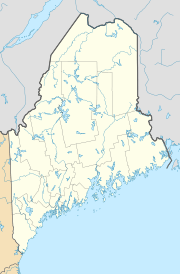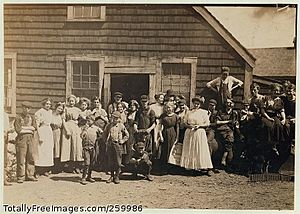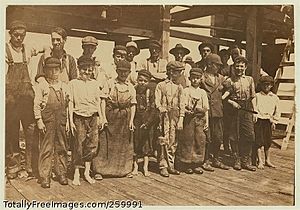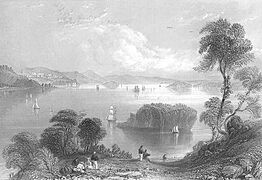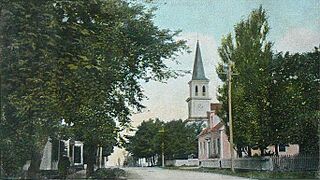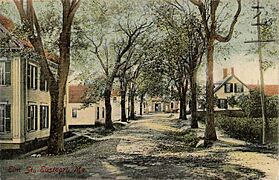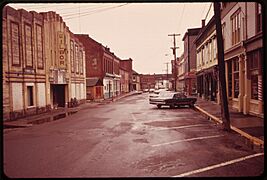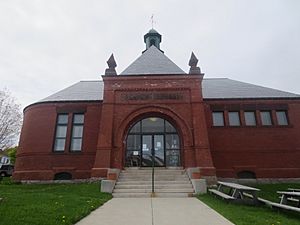Eastport, Maine facts for kids
Quick facts for kids
Eastport, Maine
|
|||
|---|---|---|---|
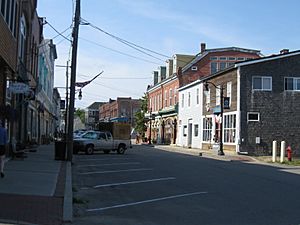
Water Street in 2012
|
|||
|
|||
| Country | United States | ||
| State | Maine | ||
| County | Washington | ||
| Incorporated (town) | February 24, 1798 | ||
| Incorporated (city) | March 18, 1893 | ||
| Government | |||
| • Type | Council-Manager | ||
| Area | |||
| • Total | 12.34 sq mi (31.95 km2) | ||
| • Land | 3.63 sq mi (9.41 km2) | ||
| • Water | 8.70 sq mi (22.53 km2) | ||
| Elevation | 105 ft (32 m) | ||
| Population
(2020)
|
|||
| • Total | 1,288 | ||
| • Density | 354.33/sq mi (136.82/km2) | ||
| Time zone | UTC−5 (Eastern (EST)) | ||
| • Summer (DST) | UTC−4 (EDT) | ||
| ZIP code |
04631
|
||
| Area code(s) | 207 | ||
| FIPS code | 23-21730 | ||
| GNIS feature ID | 0565748 | ||
| Website | eastport-me.gov | ||
Eastport is a small city located in Washington County, Maine, in the United States. It's special because it's the easternmost city in the continental U.S. (though the nearby town of Lubec is even further east). In 2020, about 1,288 people lived there, making it the least populated city in Maine. Eastport is mostly on Moose Island, which is connected to the mainland by a bridge.
Contents
History of Eastport
The Passamaquoddy Tribe has lived in this area for at least 10,000 years. Some experts even think they've been here for 20,000 years! The first Europeans to visit were led by French explorer Samuel de Champlain in 1604. They tried to set up a colony on Saint Croix Island, near what is now Calais. This was three years before the English started their first successful settlement in Jamestown, Virginia. Champlain's group had a very hard winter, and many people got sick. So, they moved to Port Royal in present-day Nova Scotia.
Fishermen and traders visited the area in the 1600s. The first permanent European settlement on Moose Island was in 1772. More fishermen from Massachusetts and New Hampshire soon joined. On February 24, 1798, Eastport officially became a town. It was named Eastport because it was the easternmost port in the United States at that time.
From 1807 to 1809, Eastport was a hub for smuggling due to a law called the Embargo Act. This law stopped American ships from trading with other countries. In 1809, Fort Sullivan was built on a hill in the village. However, during the War of 1812, a British fleet captured the fort on July 11, 1814. The British believed Moose Island was part of their territory. Eastport was returned to the U.S. in 1818. The border between the U.S. and Canada in this area was finally settled in 1842 by the Webster–Ashburton Treaty. Eastport is the most recent place in the main part of the U.S. to have been occupied by a foreign country.
In 1833, Eastport was the second busiest trading port in the country, after New York City. Farmers grew hay and potatoes. There were also factories that processed grain and made boxes. But the town's main focus was always the sea. Eastport's large harbor has tides of about 25 feet and stays ice-free all year. The first sardine factory opened around 1875. The town grew a lot as the sardine fishery and canning businesses became popular. By 1886, Eastport had 13 sardine factories, working day and night. About 800 people, including men, women, and children, worked in these factories. Eastport officially became a city on March 3, 1893.
Later, the fishing industry slowed down, and many people moved away. The city even went bankrupt in 1937. In 1976, a big storm called the Groundhog Day Gale damaged many buildings along the waterfront. Today, fishing is still important, but tourism has also become a big part of Eastport's economy.
Eastport is a port of entry, meaning you can cross the border here. An international ferry takes people to Deer Island, New Brunswick, Canada, during the summer. Every 4th of July, thousands of people visit Eastport to celebrate. Navy ships often dock there for the celebrations. Eastport celebrated its 200th birthday in 1998. Each September, the city hosts the annual Maine Salmon Festival. There's also a Pirate Festival the weekend after Labor Day, which started in 2004.
Eastport Celebrations
Independence Day Fun
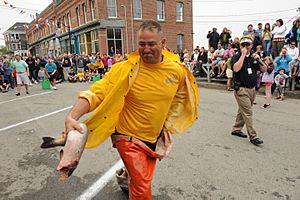
Eastport's Fourth of July celebration is a big deal! It includes "Old Home Week," which celebrates both Canada Day (July 1st) and U.S. Independence Day (July 4th). Eastport hosts the largest Fourth of July party in Maine.
The events include:
- A Grand Independence Parade with many Canadian neighbors joining in.
- Fireworks over the Bay of Fundy.
- Free entertainment at Overlook Park.
- Fun activities like greasy pole contests and water sports.
- An antique car show.
- Games and contests for all ages with prizes.
Since 1905, U.S. Navy and U.S. Coast Guard ships have visited Eastport for the 4th of July and offered free tours.
New Year's Eve Drop
Since 2004, Eastport has had a unique way to welcome the new year. They drop a giant sardine and a maple leaf at midnight!
Eastport's Geography
Eastport is known as the easternmost city in the United States. The city covers about 12.34 square miles (31.95 sq km). Most of Eastport is on Moose Island, which is located between Cobscook Bay to the west and Passamaquoddy Bay to the east. Eastport faces Deer Island and Campobello Island to the northeast and southeast, both of which are in Canada.
A fascinating natural wonder called Old Sow is located between Eastport and Deer Island. It's the largest tidal whirlpool in the Western Hemisphere!
Eastport's Climate
Eastport has a humid continental climate. This means it has big differences in temperature throughout the year. Summers are warm and often humid, while winters are long, cold, and snowy.
| Climate data for Eastport, Maine | |||||||||||||
|---|---|---|---|---|---|---|---|---|---|---|---|---|---|
| Month | Jan | Feb | Mar | Apr | May | Jun | Jul | Aug | Sep | Oct | Nov | Dec | Year |
| Record high °F (°C) | 58 (14) |
54 (12) |
76 (24) |
81 (27) |
90 (32) |
92 (33) |
93 (34) |
93 (34) |
92 (33) |
83 (28) |
71 (22) |
60 (16) |
93 (34) |
| Mean daily maximum °F (°C) | 29.8 (−1.2) |
32.1 (0.1) |
39.0 (3.9) |
49.9 (9.9) |
59.9 (15.5) |
68.5 (20.3) |
74.1 (23.4) |
73.8 (23.2) |
66.6 (19.2) |
55.9 (13.3) |
46.0 (7.8) |
35.6 (2.0) |
52.7 (11.5) |
| Daily mean °F (°C) | 21.7 (−5.7) |
24.3 (−4.3) |
31.4 (−0.3) |
41.6 (5.3) |
50.6 (10.3) |
58.4 (14.7) |
64.0 (17.8) |
64.1 (17.8) |
57.8 (14.3) |
48.2 (9.0) |
39.3 (4.1) |
28.2 (−2.1) |
44.2 (6.8) |
| Mean daily minimum °F (°C) | 13.7 (−10.2) |
16.5 (−8.6) |
23.7 (−4.6) |
33.5 (0.8) |
41.3 (5.2) |
48.3 (9.1) |
53.8 (12.1) |
54.4 (12.4) |
48.9 (9.4) |
40.5 (4.7) |
32.6 (0.3) |
20.8 (−6.2) |
35.8 (2.1) |
| Record low °F (°C) | −16 (−27) |
−14 (−26) |
2 (−17) |
2 (−17) |
24 (−4) |
30 (−1) |
44 (7) |
42 (6) |
30 (−1) |
22 (−6) |
8 (−13) |
−9 (−23) |
−16 (−27) |
| Average precipitation inches (mm) | 3.8 (97) |
3.1 (79) |
4.1 (100) |
3.7 (94) |
3.8 (97) |
3.7 (94) |
3.0 (76) |
3.1 (79) |
4.1 (100) |
4.4 (110) |
4.9 (120) |
4.3 (110) |
45.8 (1,160) |
| Average precipitation days | 12.8 | 10.7 | 11.7 | 11.9 | 12.8 | 12.8 | 11.1 | 10.2 | 10.1 | 10.9 | 12.2 | 13.5 | 140.7 |
| Source: Weatherbase | |||||||||||||
Eastport's Population
| Historical population | |||
|---|---|---|---|
| Census | Pop. | %± | |
| 1800 | 562 | — | |
| 1810 | 1,511 | 168.9% | |
| 1820 | 1,937 | 28.2% | |
| 1830 | 2,450 | 26.5% | |
| 1840 | 2,876 | 17.4% | |
| 1850 | 4,125 | 43.4% | |
| 1860 | 3,850 | −6.7% | |
| 1870 | 3,736 | −3.0% | |
| 1880 | 4,006 | 7.2% | |
| 1890 | 4,908 | 22.5% | |
| 1900 | 5,311 | 8.2% | |
| 1910 | 4,961 | −6.6% | |
| 1920 | 4,494 | −9.4% | |
| 1930 | 3,406 | −24.2% | |
| 1940 | 3,346 | −1.8% | |
| 1950 | 3,123 | −6.7% | |
| 1960 | 2,537 | −18.8% | |
| 1970 | 1,989 | −21.6% | |
| 1980 | 1,982 | −0.4% | |
| 1990 | 1,965 | −0.9% | |
| 2000 | 1,640 | −16.5% | |
| 2010 | 1,331 | −18.8% | |
| 2020 | 1,288 | −3.2% | |
Eastport's population was highest in 1900, with 5,311 people. Since then, the number of residents has generally decreased. In the 2020 census, the population was 1,288.
What the 2010 Census Showed
In 2010, there were 1,331 people living in Eastport. Most residents (92%) were White. About 3.6% were Native American. The average age in the city was 54.5 years old.
Twin Towns
Eastport has a "twin town" in another country:
 Húsavík, Iceland
Húsavík, Iceland
Education in Eastport
Shead Memorial High School in Eastport was recognized as one of "America's Best High Schools" by U.S. News & World Report in 2009. The Peavey Memorial Library has been a resource for the community since 1893.
Notable People from Eastport
Many interesting people have come from Eastport, including:
- William Beale, an author, violinist, and businessman
- Kimball Bent, a soldier and adventurer
- Nathaniel Butler Jr., an educator
- Joseph S. Cony, a U.S. naval officer
- George Pearse Ennis, an artist
- John C. Grady, a lawyer and politician from Pennsylvania
- George S. Greene, a soldier
- Harry G. Hamlet, who led the Coast Guard from 1932 to 1936
- Otis Tufton Mason, an expert in different cultures
- Joseph C. Noyes, a U.S. congressman
- Mary Hayden Pike, an author
- Timothy Pilsbury, a U.S. congressman
- Kevin Raye, a state senator
- Lorenzo Sabine, a U.S. congressman
- Karl Turner, a state legislator
See also
 In Spanish: Eastport (Maine) para niños
In Spanish: Eastport (Maine) para niños




